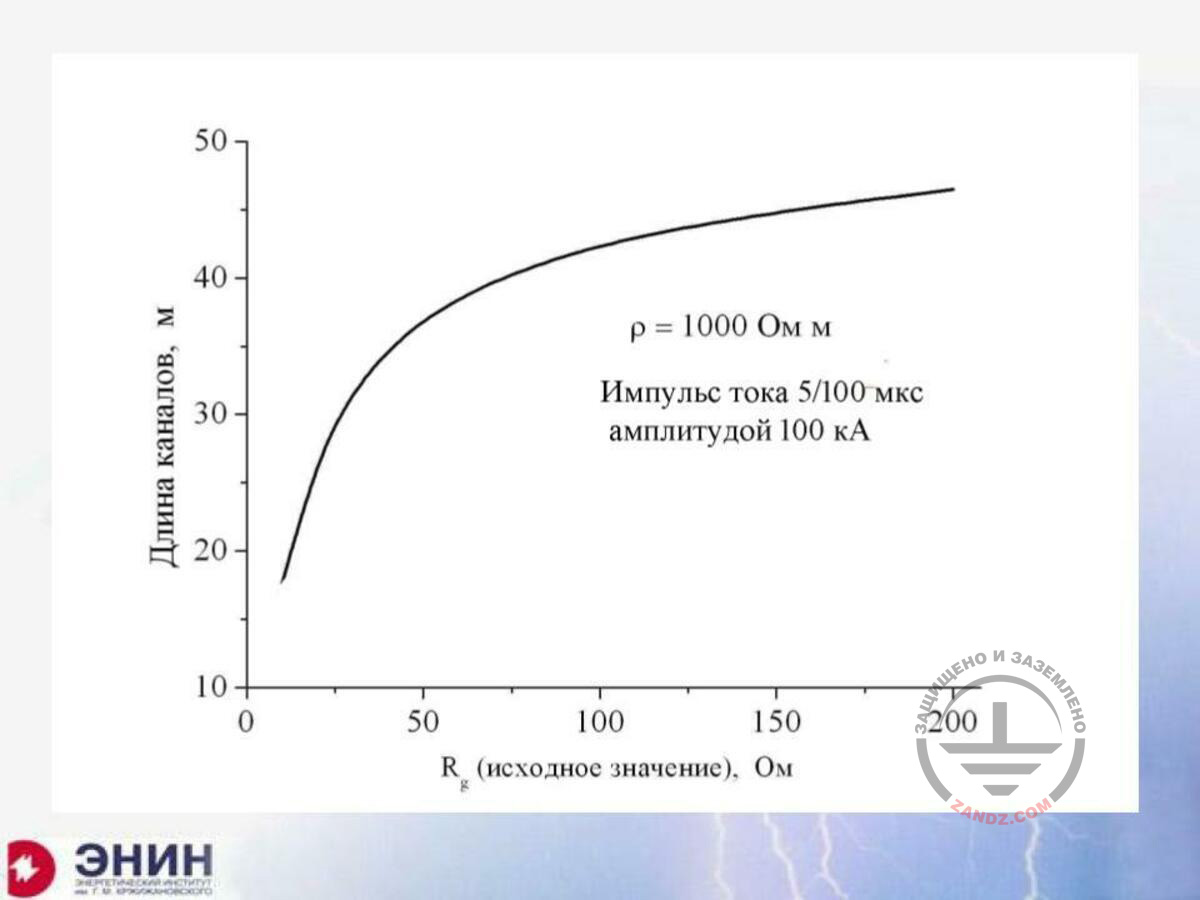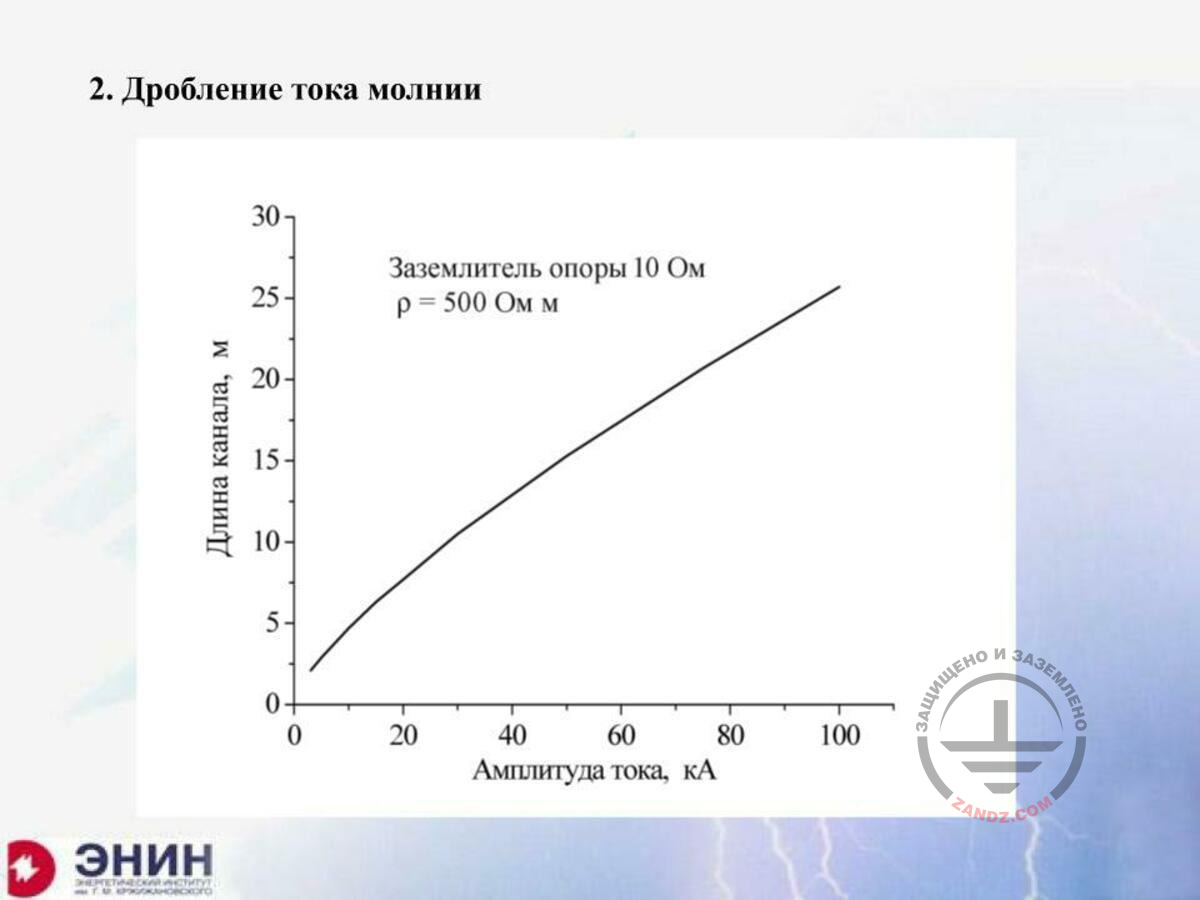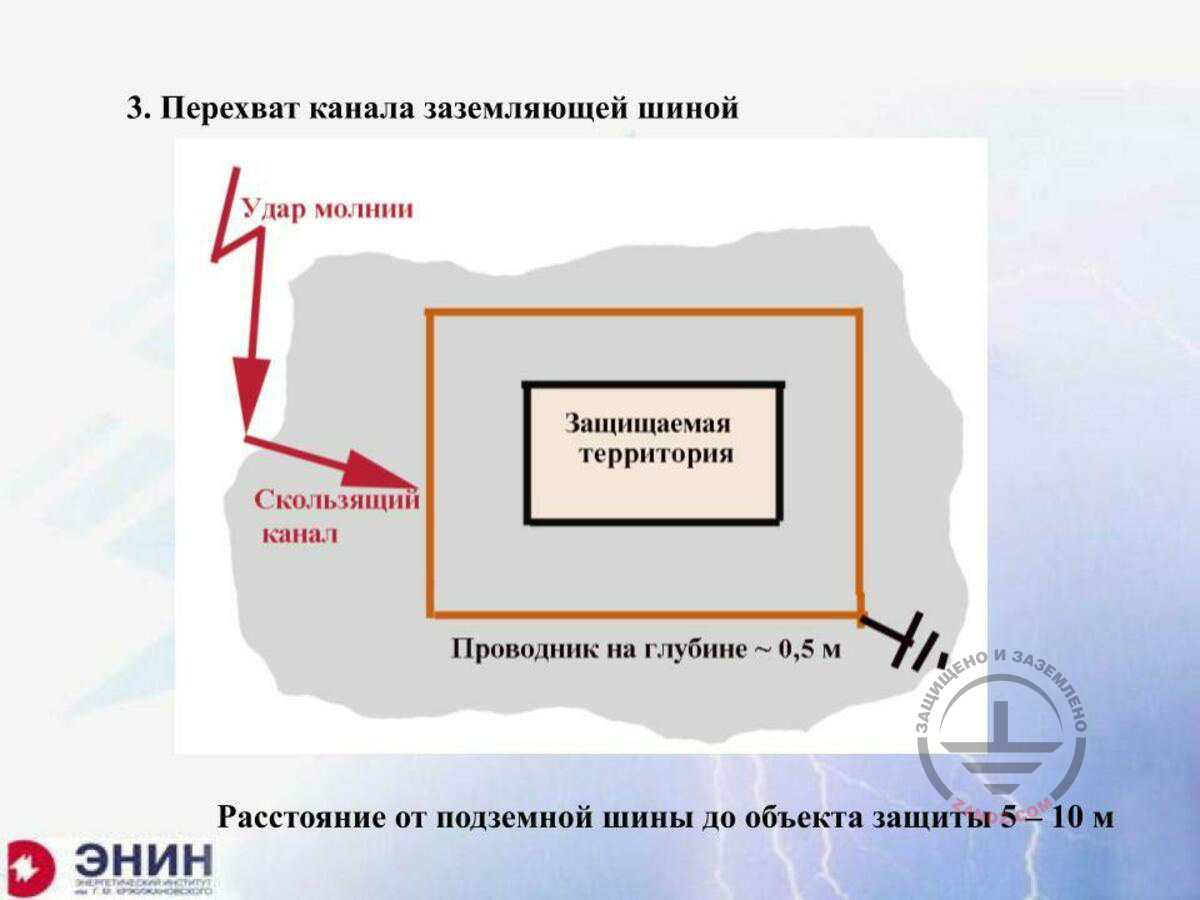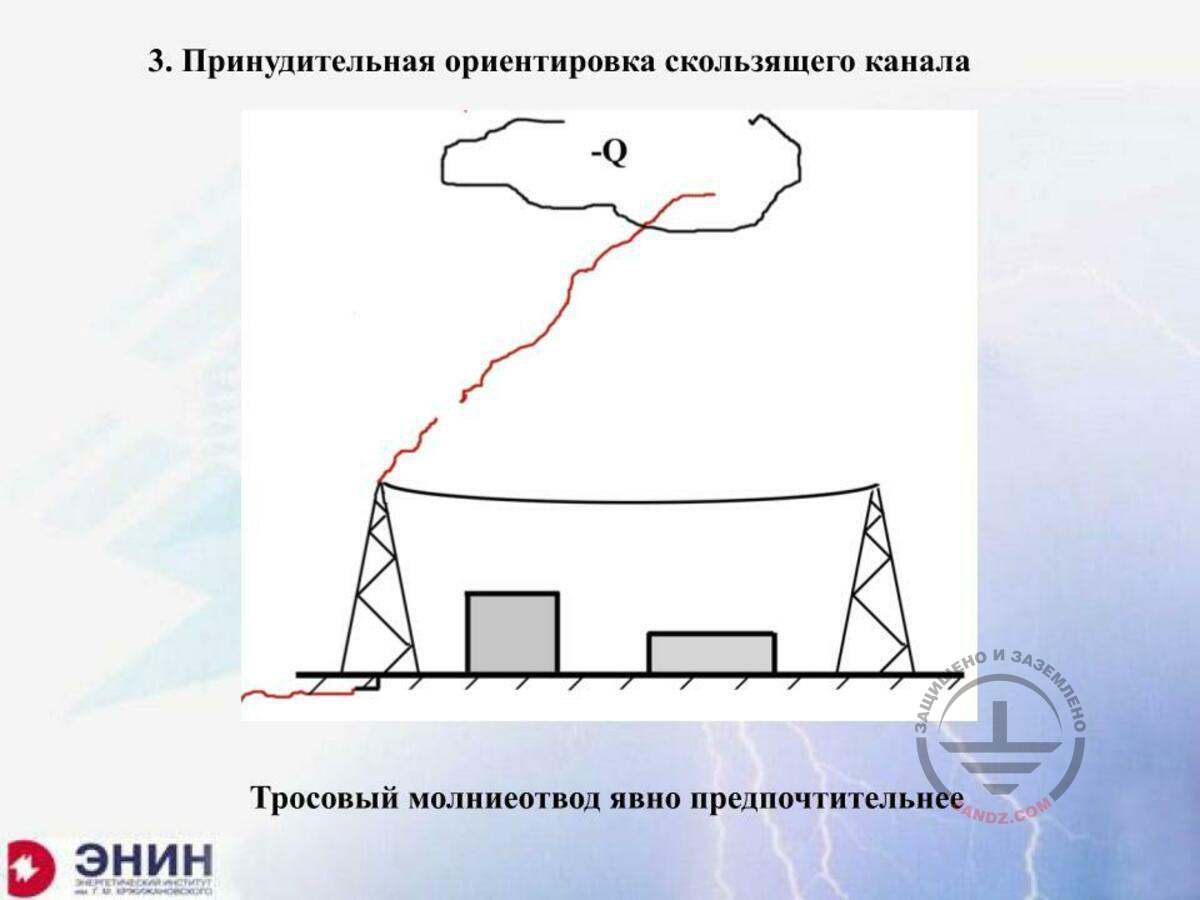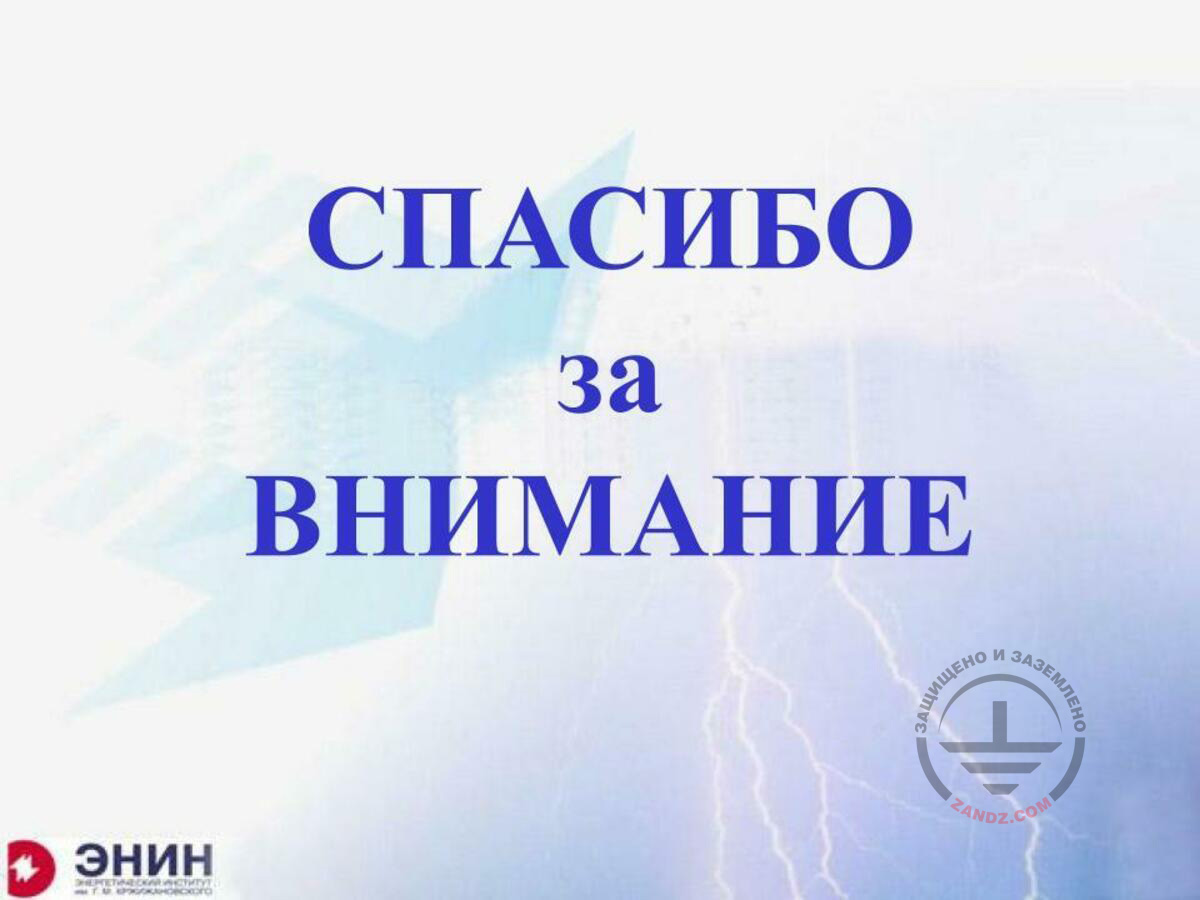Webinar text. Page 3
Fast navigation by slides:
1. Creeping discharges in the lightning protection
2. Regulatory documents for the lightning protection
3. Sarov experiment
4. Soil breakthrough according to the regulatory documents
5. Formation mechanism
6. Formation mechanism (continued)
7. Computer calculation method
8. Calculation model verification
Chart (channel lengths and Rg)
Длина каналов, м - Channel length, m
Rg (исходное значение), Ом - Rg (initial value), Ohm
ρ = 1000 Ом м - ρ = 1,000 Ohm m
Импульс тока 5/100 мкс амплитудой 100 кА - Current pulse 5/100 mcs with the amplitude 100 kA
The second point that may be is to make a very low earthing resistance. If an earthing resistance is very low, all the current will go to the earthing device; it will not go to the growing channel, but in this case, you will have some reduction in the channel length. We can ask the following question: what reduction can be obtained? If we consider a typical earthing device recommended in RD 34, the length of these spark channels will be about 20 meters. It means that we also cannot obtain a very low earthing resistance and a very short channel.
Lightning current fractioning
Дробление тока молнии - Lightning current fractioning
Длина канала, м - Channel length, m
Заземлитель опоры 10 Ом - ρ = 500 Ом м
Earthing device of the support 10 Ohm - ρ = 500 Ohm m
Импульс тока 5/100 мкс амплитудой 100 кА - Current pulse 5/100 mcs with the amplitude 100 kA
Capturing the channel with an earthing bus
Перехват канала заземляющей шиной - Capturing the channel with the earthing bus
Удар молнии - Lightning strike
Скользящий канал - Creeping channel
Защищаемая территория - Protected territory
Проводник на глубине ~ 0,5 м - Conductor at the depth ~ 0.5 m
Расстояние от подземной шины до объекта защиты 5–10 м - Distance from the underground bus to the protected object 5–10 m
Now, there is one more point that is essential. The point is as follows: let us try to catch the channels. Look here. This solution seems to be rather rational. I do the following: I have drawn a plan for the object as a territory to be protected, to which we should not let these spark channels go, and along the external perimeter of this territory, at the depth of about half a meter, I install the closed metal conductor. And we have moved it from the object for, e.g. about 10 meters. What results did I get? When this creeping channel goes to this conductor, the lightning current flows along the entire length of this conductor. As a result of this, the electric field strength is reduced dramatically, and the channel just stops. It is rather easy to make such system. This is pretty efficient. And I know that, e.g. in the USA, in order to catch such channels, they do it differently. They provide a more expensive solution of the following type. They convert the entire space to the reinforced concrete plate. They place such plates on the soil. The reinforced concrete plate has a reinforcement. When a creeping channel goes to the plate, the lightning current flows along the reinforcement rods, its density reduces dramatically, the electrical field reduces sharply, and the channel does not exist any more. Generally this solution and the American solution have the same basic idea in terms of efficiency; I think that the reinforced concrete plate is a little bit more efficient, but the effect is the same.
Forced orientation of the creeping channel
Принудительная ориентировка скользящего канала - Forced orientation of the creeping channel
Тросовый молниеотвод явно предпочтительнее - Wire lightning arrester is clearly preferred
We have one more solution to talk about. Do you remember the Russian proverb? Cut off one's nose to spite one's face. What can we do? Look here. I have a protected territory. I intentionally use wire lightning arresters (which are not really liked by the designers for some unknown reason) for the protected territory instead of the lightning rods that would have to be installed within this territory. But what do I do then? I place the supports of these wire lightning arresters a little beyond the protected territory, i.e. a little bit nearer to the neighbour. In addition to this, I do the following: I direct the earthing device for these supports to the neighbour, i.e. to the direction that is safe for me.
That is it. That is what I wanted to say in this report. I would like to add that the trucks I mentioned allow the following: you can move this truck to any object. To the object that is already present in this territory. It has an earthing circuit, all the lightning rods are installed, but there is no power equipment yet. Using these trucks and this generator which has really unique parameters, we can perform tests to see what happens to the earthing device upon exposure of the actual lightning currents, in the scale 1 : 1. This work is generally reduced to the certification tests for the on-ground structures in terms of their resistance to the lightning current exposure, which have not been performed either in Russia or in other countries. But we will have to perform them, because today, our objects are full of microelectronics, and we must not allow to burn it out. But yet, such tests are performed for aircrafts only. But they are not intended for the on-ground structures because we had no objects to perform them. Today, we have this opportunity, and there is only one thing that prevents this: our inertia and the absence of the regulatory documents that govern these. I believe that our regulatory documents for the lightning protection are completely outdated compared to the requirements of the practical lightning protection. And this is very sad. Unfortunately, I cannot suppose how to struggle with it, because it is beyond my competence and should be defined by the governmental agencies. I am ready to answer your questions.
— Thank you, Eduard Meerovich! We have comments on this slide from Yury: "No customer would allow to install 50-meter masts with the thick wire. We have already had such situation in Ustyansk." Andrey has also confirmed that he had this experience. We can say several words for this.
— You know, the point is that I can explain the following on this slide. We have performed this work for "Rosseti". We have proposed the system and obtained the following result: first, the price of this system was higher within several dozens of per cent, which is not really important because the price for the lightning protection compared to the entire object is only about 1%. We are talking about bad savings, do you understand it? This is the first point. Now, the second point: no powerful masts and thick wires are needed because the wire we can use for the distance of, e.g., 150 meters, in the areas from about the fourth area in terms of wind load and icing. It is not a problem to provide its reliability. The third point is a prejudice typical of Russia, but it is also present in many other countries. For example, in bad soils, e.g., in the Alps, the high-voltage electrotechnical objects with the wire lightning arrester are typical; they are used for many years. And nothing happens to this wire. But our customers are not used to it. Why do I say that we have no regulatory document?
— Thank you! We have one more comment: "From what material and with what cross-section should we create a protective circuit around the object?"
— The requirements to the circuit are the same as to any other earthing bus. They are provided in any regulatory document. It means that if your soil is not aggressive, you can use steel with the cross-section 70 mm2. Read SO-153. It contains the table for steel, copper; aluminum cannot be buried in the soil. You can use these materials. You can use the zinc-coated material, copper-coated material, stainless steel, i.e. anything that is suitable for earthing electrodes is also suitable for this electrode. This is a typical earthing electrode.
— Good, thank you! One more clarification: "Should we combine the earthing device of the lightning arrester and the complex earthing device of the object in this case?"
— This is not an earthing device for a lightning arrester. Is it clear? I have shown to you the following. You have an object and you have a protected territory. You have an earthing circuit in this protected territory, to which anything located here is connected. And this is a safe territory wherein lightning arresters are installed and wherein the objects are located that play their role, e.g. large trees or an UHV communication tower, or anything else. About once a year, a lightning will strike this 100-meter UHV communication tower, and a creeping discharge will go from the tower to the protected territory. But I do not want to permit this creeping discharge. And for this reason, beyond the protected territory, having moved away from it for about ten meters, I make a closed circuit with a single function, i.e. to catch the creeping discharge.
— Thank you. Let me go to the "Questions" tab and read the questions from there: "Should lightning rods have a contact with the roof in case of the metal roof?" I mean metal holders and isolated holders."
— The point is in what lightning protection has been ordered from you and what lightning protection you are creating. If you create an isolated lightning protection, then it is natural that your lightning rod should be placed onto the isolated support designed for the voltage existing here. And you should have an isolated current collector that will direct the lightning current somewhere to the side. If it is a typical residential building, and you only use the lightning rod with the sole purpose, i.e. to provide your roof integrity. In this case, the lightning rod can be attached to the metal of the roof, e.g. to the metal profile. Therefore, it depends on your task.
— Probably, it is hard for me now to comment because of the following. I do not know what soft reservoirs are. I know that previously, we used the reinforced concrete reservoirs, and I know what they are. But I do not know anything about soft reservoirs. If you provide me with the source materials, I will be able to answer this question.
— Good. Vladimir, in this case, it is better for you to write to our e-mail. I will send this question to the chat a little bit later to clarify the information on soft containers. And then we will provide this information to Eduard Meerovich. He will answer the question. Let's go further: "What is the reason for that the spark discharge from the directed earthing device will also be directed to the proper side but will not flow along the multi-rayed scheme as in case of the typical earthing rod?"
— No. The point is that if your lightning current flows to all directions as in case of a conventional earthing device, in this situation it will be that you will not have a creeping discharge. If you do not have it, then it is great. You have nothing to worry about. The point is that the danger is the case when these discharges occur. If it occurs, such a directed electrode will provide a starting direction to this discharge. It will not rotate for 180°. And naturally, in case of flowing, it is good. What do you have to worry about then? There is no creeping discharge.
— According to the federal standards and rules in occupational safety, the rules have been approved by the order stating that the earthing devices of the lightning arrester that protect against the direct lightning strikes should be separated from the earthing devices of other systems. And the lightning protection category is not detailed. I think that federal standards and rules do not state, intentionally or accidentally, that this requirement refers to the standalone lightning arresters that provide lightning protection of the first category. What do you think?
— I cannot think anything of the document I have no relation to. I can only say one thing: a standalone lightning arrester is a lightning arrester that is, according to the EIC and RD 34, separated from the object in the air and on the soil with a particular distance that is calculated using the formulas provided in both documents. If you look at what distance we are talking about you will see that these distances have a range of about 4 to 10 meters. And it is believed that with such distance, the lightning current that strikes a standalone lightning arrester does not affect the lightning arrester of an object. Our current webinar shows that it is incorrect because this impact may be due to the fact that a creeping channel will go from the earthing device of the lightning arrester, which covers this distance of less than 10 meters in almost any circumstances. And the standards provided in the EIC and RD34 are the standards that do not meet anything today. It is the first aspect. Now, the second point is the following. If you do not have even a creeping discharge, then with such distance, the conductive coupling through the soil conductivity is so strong that at least 15% or even 20% of the lightning current go to the earthing device of the object because the distances rated in the EIC are unacceptably short. They should be changed and they have to be changed.
— Good, thank you! We had several questions: "Are there any statistical data of the creeping discharge occurrence?" Can you comment on this?
— No, I cannot, because nobody collected such statistics. We tried to do something like this but it was unsuccessful. We have a very poor situation with statistical data. The entire lightning current statistics that is used in all regulatory documents is the statistics obtained in the high objects. For example, the majority of good recordings of lightning currents was made on the San-Salvatore Mountain in Switzerland. How were they made? A tower of 70 meters high is installed on the mountain in the rocky soil. An earthing device goes from this tower. It lowers to the Lugano Lake, and this earthing device that is installed almost 600 meters higher than the tower. As a result of this, the data on lightning currents we collect in the objects with the height of several hundred meters. And then such data are transferred to the objects of a normal height because the power line is about 20 to 30 meters long. Residential complexes are, again, 20 to 30 or sometimes 40 meters. The industrial objects are the same. It means that we use the statistics that has been obtained in completely different conditions. Unfortunately, nobody in the world collects this statistics. You can say: "What about the remote methods?" So, the error of remote methods in determining the lightning currents is about several hundreds of per cent. You cannot rely on it. This is a bad situation with the statistics.
— One more clarification for this slide. Probably, the point is not about the cost (you have mentioned the cost of the wire lightning protection), but in the building footprint? One more clarification: "What area is needed for wire lightning arresters?"
— The point is: certainly, it is not so great with the area consumption, because supports of wire lightning arresters, as our serous studies have shown, it is preferred to install wire lightning arresters beyond the protected area for about 15 to 20 meters. Surely, it is not always possible. And it is never possible in the urban area. But we have many territories where no urban construction is located, and it can be used there but it is not yet used.
— Thank you. One more question, I suppose, regarding the same slide: "Is the earthing protection circuit not connected to the internal circuit? Because, according to the rules, we are supposed to connect the earthing circuit."
— And this is not the earthing circuit. You should not connect it to the internal circuit. You should not. Moreover, you should move it. You must understand that it is not the earthing circuit. The earthing circuit is a completely different thing. This is the lightning arrester, but it is the lightning arrester which is not installed at the top to attract the lightning from the top but it rather takes such a creeping discharge.
— Thank you. Probably, you should also send the question to the e-mail, but I will read it and you tell us: "If we have a large handling terminal with lifters and conveyor galleries. How can we provide protection against creeping discharges in this case?".
— Describe some parameters of this circuit and send what it is like and I will surely try to answer it.
— Anna, I have sent the e-mail to the chat. Look at it a little higher and I will send it once again later. Send more detailed information and Eduard Meerovich will answer it. Clarification from Nikolay: "Should we make a grid and how many risers from the earthing device or is it enough to use rod iron on the roof ridge only?" I do not know, maybe I also need a clarification. Nikolay, please clarify your question.
— What are you talking about? Please ask a particular question and I will try to answer it. It is easy with the number of risers. We have document SO-153 that specifies that the riser number is defined by the lightning protection level. For the first level, the distance between the risers should not be more than 10 meters, for the second level, it is 15 meters, for the third level, it is 20 meters, and for the fourth level, it is 25 meters. Highlight the perimeter and look at how many risers you need.
— Nikolay has clarified that it is a warehouse. Nikolay, write in the chat. When we have details, we can answer it. We have a comment from Valery: "There is also lightning protection on Baikonur. Eduard Meerovich, what can you say about its efficiency?" If possible, comment on this.
— I do not know anything about the lightning protection on Baikonur because other specialists have installed it. But as far as I know, unofficially, there are two lightning arresters over 150 meters high. However, we have this information about Baikonur East. It is available in the internet. Internet offers many articles regarding this. They say that the starting position is protected with two lightning arresters having 150 meters high, and a row of lightning arresters is also used, which has a smaller height. Any person may access the Internet and read these articles. What concerns do I have in terms of the protection of high lightning arresters? I have already told about it and I repeat again. The modern equipment is packed with microelectronics. Today, the greatest danger of the lightning is not its destructive force, not its thermal effect, but rather its electromagnetic field. It is because the electromagnetic field affects the microelectronics and leads to its failure. What does it mean when you have installed high lightning arresters with the height of about 150 to 200 meters? It means that you have attracted many lightnings to these lightning arresters. If these are the lightning arresters of 150 meters high, it will have about more than one strike per year. And it means that you will have a near lightning discharge more than once a year that will take a strong electromagnetic field affecting the entire microelectronics. I would have tried to solve this task using the lower lightning arresters. It is because the smaller lightning arresters collect lightnings from the smaller territory, and the frequency of such dangerous electromagnetic impacts will reduce. Recently, we have done the work for the power industry, which has shown that in all cases we have an aim to provide high reliability against the direct lightning strikes using the lightning arresters of a lower height.
— Thank you. Dear colleagues, write in the chat if you have any questions. If you do no have any, then write to us so that we could understand it. We have several more minutes to answer your questions, and then we will finish. There is the following question: "How can we calculate the distance to install this circuit of the protected object?" As far as I understand, we are still talking about the same slide .
— If I had to do it, I would do it at the distance of about at least 5 meters but not more than 10 meters, and the reason is as follows. We need to obtain that between these two things, in the external circuit that is highlighted in red and located in the figure, and the black one, a small conductive coupling would exist. The distance at the level of 10 meters for this is quite sufficient.
— Thank you. If an intermediate floor of an industrial building is made of metal bars and runs and is supported by the metal columns, should we provide the lightning protection for this building?
— It depends on one thing only. Neither columns nor metal intermediate floors do not protect buildings against water leaks, but not the lightnings. And you have some roof and what does this roof do? Will it burn after the lightning strike? Or it will not? If it breaks through, is it allowable or not? This is determined by the customer. If the customer requires that he does not care and let it be that, e.g., once in ten years the lightning strikes this roof, it will be repaired, and that is it. Then you should not protect it in this case. But if the customer states that nothing should happen with the roof in any case, you have to provide protection. You have to install lightning arresters, and in these cases, it is better to install many small arresters than two or three high arresters. This is true. The European experience shows that they prefer using many lightning arresters.
— Thank you. One more clarification about the Baikonur protection: "Lower lightning arresters do not protect the rocket then."
— You know, let's talk in very simple words. Can you use another solution? Sure, you can. For example, you can protect this rocket by placing it between two wire lightning arresters. The protection will be provided, but then people may object. How did we calculate this height for lightning arresters? According to my opinion. We have a system for saving spacemen at the zero height. If something happens to the first stage of the rocket, when the rocket is at the start, main propulsion motors trigger and release a capsule with spacemen for the safe distance. This has been done correctly. If lightning arresters are installed nearby, then such lightning arresters will be an obstacle, and you need to move them for the capsule flight radius, but they will be very high in this case. Is there a way out of this? Surely, there is. These lightning arresters may be foldable. For example, you have two wires that protect the rockets, one-minute signal, firing cartridges trigger, and the wires fall down to the earth. Nothing happens with the rocket or with the lightning for the minute, you can be sure in it. This is not my solution. I am not its author.
— Thank you. Let's read the final question: "According to the chart shown in slide 3, it is sufficient to earth the conductor circuit in a single point?" Oleg, please specify whether it is the third slide?
— If you are talking about it, then you should not earth it anywhere because it is in the earth. This is shown conventionally that it is in the ground.
— Sergey, we have seen your question. It is large and we cannot answer it right now. These questions are saved, and we will send it to Eduard Meerovich who will answer them. And there is also a question from Alexey. We have also saved it and it will be answered in writing. Colleagues already thank us for the webinar. Thank you very much, Eduard Meerovich!
— Dear colleagues! Your feedback to my work is very important for me. We have already planned many seminars. And if you send either some critics, or some positive points, some recommendations to me, I will be able to make these reports more useful for you. Therefore, your feedback is very important for me. Do you understand? Do not be so greedy, please send it.
— Yes, Eduard Meerovich, once again, thank you for the webinar. We have already received many thanks and gratitudes in the chat to you. I repeat, the outstanding questions will be saved and sent to Eduard Meerovich.
Thank you for your attention!
СПАСИБО ЗА ВНИМАНИЕ - THANK YOU FOR YOUR ATTENTION!
<< Previous page
slides 9 to 16
Related Articles:
 2019 ZANDZ Competition for the Best Earthing System and Lightning Protection
2019 ZANDZ Competition for the Best Earthing System and Lightning Protection

 Lightning Protection of Large Territories: Parks, Grounds, Plant Territories. Page 1
Lightning Protection of Large Territories: Parks, Grounds, Plant Territories. Page 1
 Lightning Protection of Large Territories: Parks, Grounds, Plant Territories. Page 2
Lightning Protection of Large Territories: Parks, Grounds, Plant Territories. Page 2
 Lightning Protection of Large Territories: Parks, Grounds, Plant Territories. Page 3
Lightning Protection of Large Territories: Parks, Grounds, Plant Territories. Page 3


